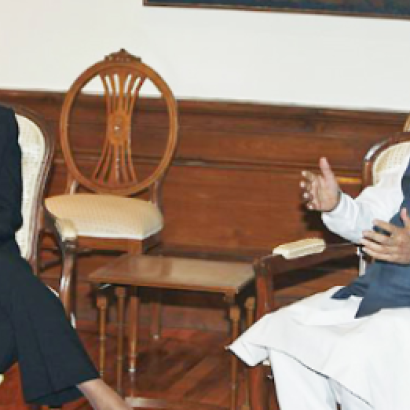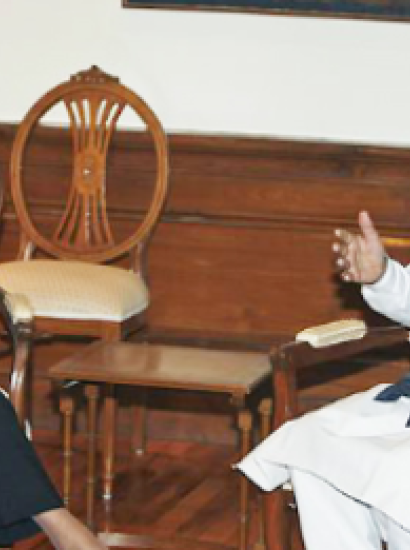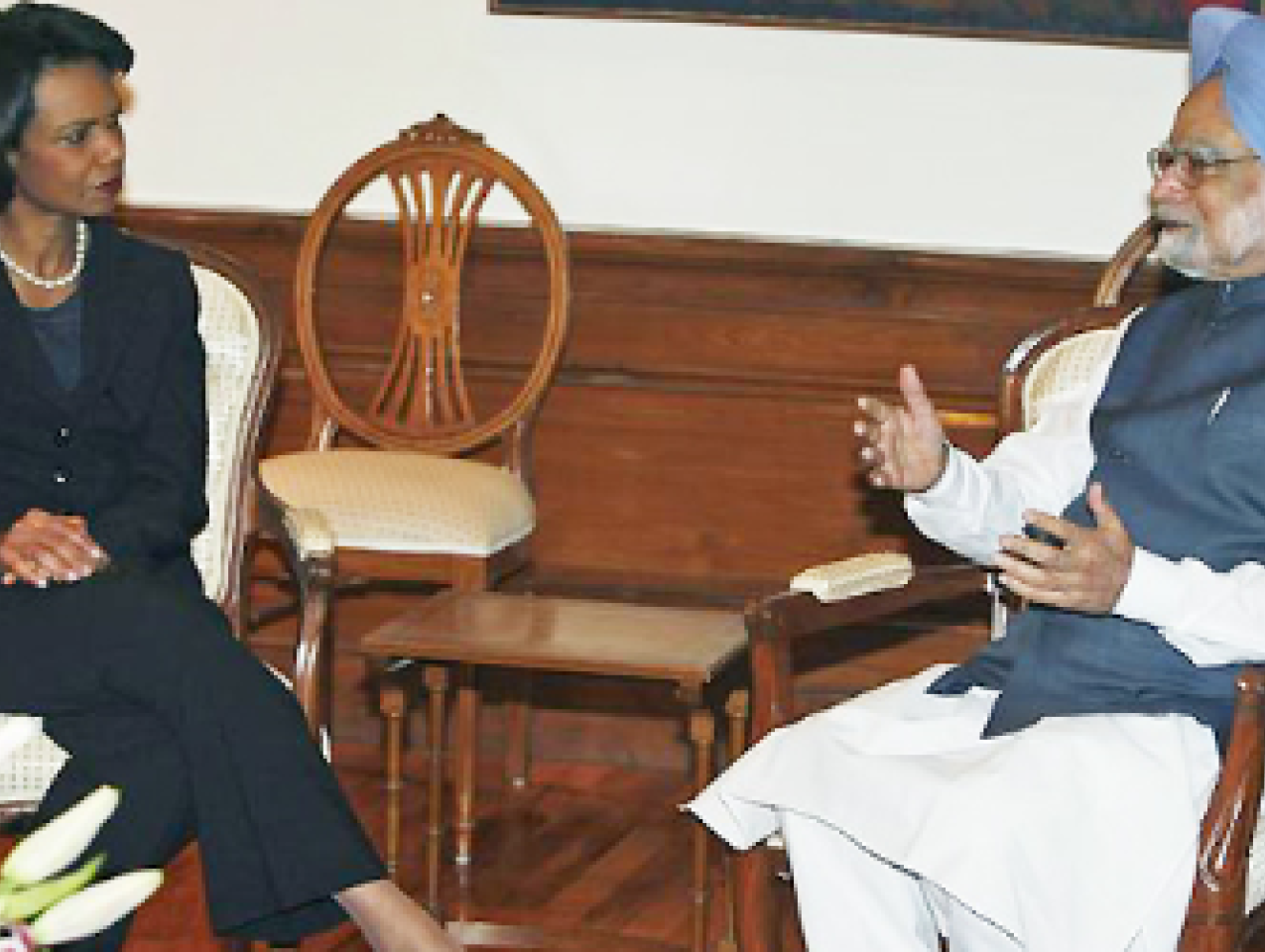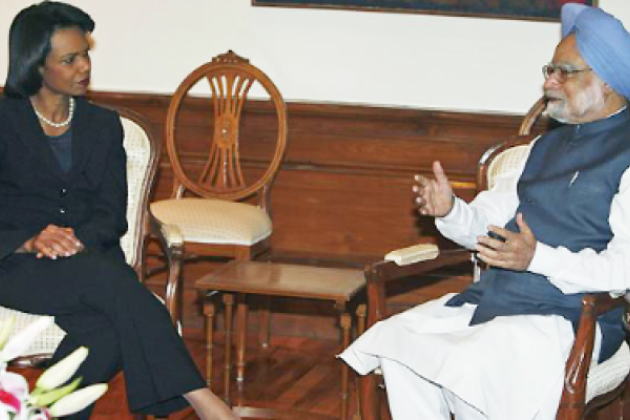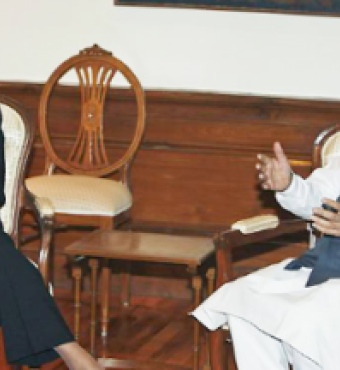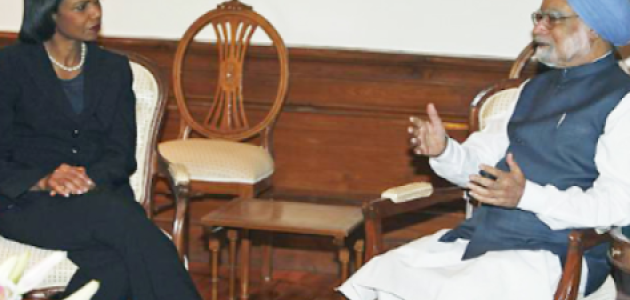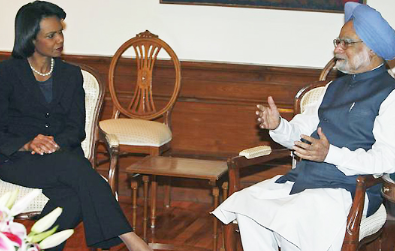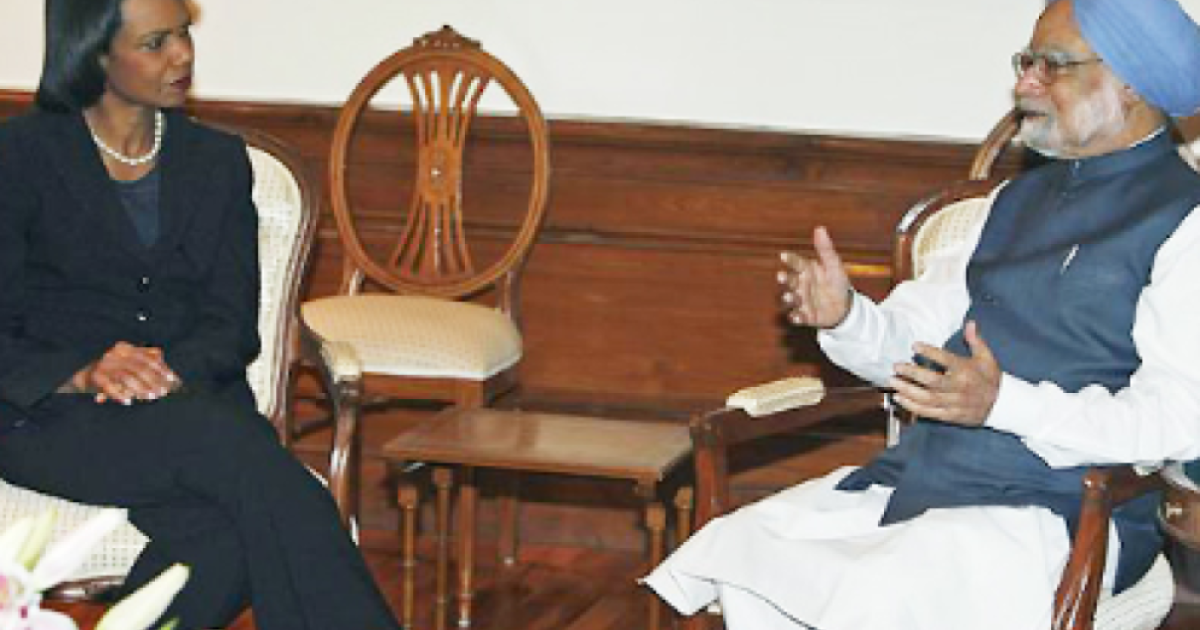Editor's note: The following essay is an excerpt from the book, "No Higher Honor: A Memoir of My Years in Washington," by Condoleezza Rice
…On February 28 [2006], the President left for India, Pakistan, and Afghanistan. The trip required the most delicate balancing act to get the messaging right in each of the places. Our delinking of relations with Islamabad and New Delhi was working—there was no more talk of U.S. policy toward India-Pakistan, or Indo-Pak, as it was sometimes called. We now had distinct approaches to both important countries. And we were doing really well with India: while there the President would sign the landmark civil nuclear deal.
The nuclear deal was the centerpiece of our effort to build a fundamentally different relationship with India. From the earliest stages of the 2000 campaign, it had been our intention to change the terms of U.S.-Indian engagement. As I noted earlier, the crucial nuclear agreement required breaking many taboos. India had refused to sign the NPT in 1968 and had then conducted a nuclear test in 1974. Only five countries had been “grandfathered” as nuclear powers in 1968—the United States, the Soviet Union, Great Britain, France, and China. Any country that subsequently acquired a nuclear capability was deemed to be in violation of this important set of prohibitions. In 1978 President Jimmy Carter signed a bill that cut off all nuclear trade with India.
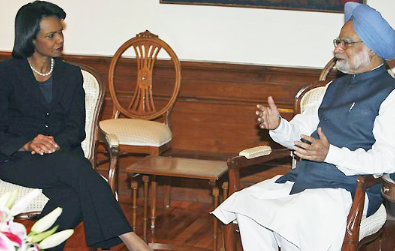
Photo credit: Google images
The United States thus maintained a web of restrictions on technology transfer and cooperation with India. The list of prohibitions grew over the years, with the condemnation reaching its height in 1998. That year, in response to a long-range missile test by Pakistan, Prime Minister Atal Vajpayee authorized the Indian military to conduct a series of underground nuclear tests, including India’s first test of a thermonuclear weapon. When Pakistan followed up with its own nuclear test, the two countries became linked as the poster children for crimes against the non-proliferation regime.
Their behavior was different, however. India had developed an excellent record of respecting proliferation safeguards in terms of not transferring technology to other countries. Pakistan—well, it was the home of the nuclear proliferation entrepreneur A. Q. Khan, who had spread nuclear enrichment technology to North Korea and Iran, among other places.
India needed civil nuclear power and wanted to break out of the constraints on high-technology cooperation that were stunting its growth. The proposed civil nuclear deal would make it possible for the United States—and American companies—to help India develop its potentially rich market for this environmentally friendly energy source. But the breakthrough was not just about nuclear power—it would unlock a wide range of possible areas of cooperation with a country that was an emerging power in the knowledge-based revolution in economic affairs. The Indians made clear, too, that they hoped to become a customer for U.S. military hardware. That was an exciting prospect for the defense industry. And for us, even though we were not seeking to “balance” China, cooperation with another emerging power in Asia, especially a democratic one, was a welcome development.
The interests of the United States and India were in substantial alignment. But any change of this magnitude brings resistance. In Washington, the high priests of non-proliferation accused us of gutting the NPT, a treaty that had significantly limited the emergence of nuclear weapons states.
Our problems were considerable in 2006 but Indian Prime Minister Manmohan Singh’s were far more complicated, stemming from the Indian national security elite’s almost existential attachment to the “independence” of its nuclear program. For some officials, the requirement to place India’s nuclear reactors (only the existing civilian ones and any new ones) under IAEA supervision amounted to nothing less than an attack on India’s sovereignty. Many of those Indian bureaucrats and pundits also valued their country’s “non-aligned status,” a relic of the Cold War, when India had declared itself as belonging to neither the Soviet nor the American “bloc.” When confronted with that argument, my Indian counterpart, K. Natwar Singh, said, “The Cold War is over. Exactly against whom are we non-aligned?” Good point. But for many in New Delhi the idea of close technological cooperation with the United States was just too much to swallow.
To some, the requirement to place India’s nuclear reactors under IAEA supervision amounted to an attack on India’s sovereignty.
As a result of these tensions, the deal suffered several near-death experiences before and after Singh and Bush signed it in New Delhi. The first had come a year before in Washington, when Prime Minister Manmohan Singh visited the United States in July 2005.
The two leaders were expected to sign a framework document to end the moratorium on nuclear trade and pave the way for a full agreement on civil-nuclear cooperation. I met the day before with my Indian counterpart Natwar Singh in his suite at the Willard Hotel. Frankly, there was so much buzz around the State Department that we wanted to work in a location away from the press and where the atmosphere was more informal. I also thought it a sign of respect to go to him, even though we were in Washington.
Natwar was adamant. He wanted the deal, but the prime minister wasn’t sure he could sell it in New Delhi. We pushed as far as we could toward agreement. Finally, Natwar said that he would take the document to the prime minister and let me know.
That evening, [Undersecretary of State for Political Affairs] Nick Burns asked to see me. With Bob Zoellick, the deputy secretary, and several members of the senior staff, Phil Zelikow, Brian Gunderson, and Sean McCormack, in tow, he came down the hall from his office and entered mine. “It isn’t going to work,” Nick said. “The foreign minister tried, but the prime minister just can’t sign on to the agreement.”
I was a bit surprised, perhaps having misread Natwar’s determination as an indicator that he had the authority to speak for his government. It was late, and I was tired. “Well, if they don’t want to get out of the nuclear ghetto, I can’t do anything about it,” I said. “Why don’t you go and meet with the Indians and try one more time.” I called the President. “It isn’t going to work. Singh just can’t make it happen,” I said.
“Too bad,” he answered and didn’t press further. Later that night Nick called to tell me what I already knew—there wouldn’t be a deal. I went to bed, constructing a script in my head for the press the next day about needing more time for the negotiations. That sounds lame, I thought as I drifted into a fitful sleep.
I woke up at 4:30 a.m. and sat straight up in bed. I am not letting this go down, I thought. I called Nick at 5:00 a.m. “I am not prepared to let this fail. Arrange for me to see the prime minister,” I said. The meeting with the President was set for ten. “How about breakfast at eight?” Nick called while I was exercising to say that the prime minister didn’t want to meet. “Get the foreign minister,” I answered. Natwar picked up the phone. My heart was beating pretty fast—maybe from the exercise, maybe from the sense of an important initiative slipping through my fingers. “Natwar, why won’t the PM see me?”
“He doesn’t want to tell you no,” he said. “I’ve done my best. I told him that the United States wants to take this thirty-year millstone from around your neck. You should do it. But he can’t sell it in New Delhi.”
I wasn’t ready to surrender. “Ask him again,” I pleaded. A few minutes later, Natwar called to say that the prime minister would receive me at his hotel at 8 a.m.
I went to the office for a few minutes and then to the Willard, having called the President to tell him I would try personally one more time. Steve asked if I wanted him to go with me. “No, I think I need to do this alone,” I said. I entered the prime minister’s suite and sat there with Natwar and his boss—all three of us not bothering to touch the pastries and coffee that had been served.
“Mr. Prime Minister, this is the deal of a lifetime. You and President Bush are about to put U.S.-Indian relations on a fundamentally new footing. I know it’s hard for you, but it’s hard for the President too. I didn’t come here to negotiate language—only to ask you to tell your officials to get this done. And let’s get it done before you see the President.” Prime Minister Singh, a mild-mannered man who speaks slowly and softly, pushed back but eventually gave the nod to his people to try again.
There was a lot of discussion—but no commitment—regarding India’s pursuit of a permanent seat on the UN Security Council.
I went directly to the White House and told the President what I’d done. When the Indians arrived, our negotiators and theirs sat in the Roosevelt Room, trying to find agreement, while the President, Prime Minister Singh, Natwar, and I sat nervously in the Oval pretending to focus on other matters. Finally, I got a note to join the negotiators. Natwar and I entered the room to the smiling Nick Burns and his counterpart. “We’ve got it,” Nick said.
The two leaders released the framework agreement to the press, most of whom were already writing stories of failure. Bob Zoellick came into my office. “Sometimes the secretary of state gets tested. You wouldn’t take no for an answer,” he said. I felt very good, but the New York Times’s editorial board soon reminded me that there would be a push back. The U.S.-India deal, it opined, would cause responsible NPT signatories to “be more inclined to regard the non-proliferation treaty as an anachronism, reconsider their self-restraint, and be tempted by the precedent that India has successfully established and that now, in effect, has an American blessing.”
The arguments from the non-proliferation community were not without merit. The whole premise of the regime was that countries who pursued civilian nuclear power under safeguards—inspections, reporting, and so on—would not pursue military weapons programs. It was too easy, it was thought, to divert technology from one to the other. That, some said, had been the argument vis-à-vis Iran. How could we argue that India was different?
It was a good question, but, unlike Iran, India was not lying to the IAEA about its enrichment activities and the fact of the existence of a military program was well known. Though ideally India—or Pakistan, for that matter—would not have built a nuclear weapons program, this was now a fact of life. The key from our point of view was to get India within the IAEA regime, even if they could not and would not be party to the NPT. Our thinking tracked closely with that of Mohamed ElBaradei, the head of the IAEA and thus the guardian of the NPT. Better to have India in the tent in some fashion, even if New Delhi could not formally join the NPT. ElBaradei understood this point.
At least new construction of reactors would be under safeguard. India already had more than enough nuclear material for its military program. It needed help on the civilian side and we needed the strategic breakthrough with this emerging, democratic power.
The work to move from that initial announcement of a civil-nuclear deal in 2005 to a more detailed framework agreement by March 2006, when the President would visit New Delhi, was extremely difficult and the effort almost failed several times. The prime minister had indeed encountered difficulty when he returned home from Washington in the summer of 2005. By the time of the trip, the Indian delegation was trying to walk back some of the language on IAEA safeguards. Steve and Nick went to the Foreign Ministry to try to hammer out a solution. I thought that I would stay away this time, giving us another bite at the apple should they fail. After several ups and downs and near misses over a period of eight hours, they succeeded. The United States and India had a civil-nuclear deal. Now the really hard work would begin. The reality was that the deal could not go into force until we met a number of criteria stipulated by U.S. law. But we’d lived to fight another day—and that was good enough for the time being.
The nuclear deal was the news of the President’s visit to India. Yet other elements of the trip demonstrated why it was time to change the relationship with this emerging global power. I remember well the President’s meeting with students at the business school in Hyderabad, a center of technological sophistication that personified India’s potential as a high-tech leader and economic dynamo. This could be Stanford, I thought.
There was a lot of discussion—but no commitment—regarding India’s pursuit of a permanent seat on the UN Security Council. The Indians had a good argument and one for which I had some sympathy. The UN Security Council did not reflect the changes in the balance of power that had taken place with World War II. International institutions are like the rings of a tree—you can date their birth by looking at their membership. The original permanent five members of the Security Council (those with veto authority) were the Soviet Union (Russia became the successor state in 1991), China (with the PRC replacing Chang Kai Shek’s ROC in Taiwan in 1971), France, the UK, and the United States. But now there were other important powers and whole continents that were not represented. What about Japan, the world’s third largest economy? What about the Middle East? And of course the emerging market powers of Brazil and India did not hold permanent membership either.
The meeting with Pakistan’s President Musharraf was dominated by talk of terrorism and our response.
The United States had long championed Japan’s case but frankly the politics of UNSC reform were just too complicated to take on. The incorporation of India was opposed by China. Brazil’s candidacy raised the question of Mexico’s exclusion. The Africans could never settle on a candidate to represent a continent split between the Arab north and the Sub-Saharan black south. And reform would have raised a sticky question for our closest allies. Germany wanted membership, too. Did it make sense to have three European representatives—particularly when the European Union was supposed to have a common foreign policy?
We adopted a strategy of acknowledging the importance of reform and welcoming reasonable proposals, but we never acted on any of them. That said, the continued focus on the issue by emerging powers such as India underscored their growing insistence on a voice in international affairs.
***
By way of contrast to our time in New Delhi, the trip to Pakistan began with the news upon arrival that there had been an attack on the U.S. consulate in Karachi. A U.S. consular officer had been killed. The President, always gracious to his hosts, endeavored to convince the Pakistanis that this in no way cast a shadow on the visit. But of course it did. There was an air of unreality as we fought to make the visit appear normal. The Pakistanis had been insistent that the President sleep just one night in Islamabad to show that it was safe. After a lot of debate, he decided to push the Secret Service beyond its comfort zone and grant the Pakistanis’ request: we’d stay at our ambassador’s fortress-like home.
The contrasts continued. The meetings with Prime Minister Singh had been focused on technological cooperation and removing bureaucratic barriers to foreign investment. The President met for lunch with the members of a joint U.S.-Indian CEO council. But the meeting with Pakistan’s President Musharraf was dominated by talk of terrorism and our response.
And it wasn’t just the conversation that was different. In India, we were treated to a beautiful dinner outdoors on the veranda of the Presidential Palace, a fresh breeze blowing through as we looked out across the beautifully manicured grounds. In Pakistan, aware that we needed to be wheels up for Washington that evening, we sat in the Palace for a hurried two-hour dinner and a “cultural performance” that oddly featured a Western-style fashion show.
Still, the visit to Islamabad allowed us to see a glimpse of a different Pakistan. Musharraf, a classic “man on horseback” who came to power in a military coup, was making important changes in his country. I was struck by the presence of strong women ministers representing the Pakistani government in our meetings. It was also encouraging to see a vibrant press corps peppering both presidents with questions about everything from the possibility of a civil-nuclear deal with Pakistan—not possible from our point of view—to expectations about coming elections in the country. For all his limitations, with the freeing of the press and of the judiciary, Musharraf had laid the groundwork for a civilian government to return. Ironically, those changes would soon turn out to be his undoing.
India and Pakistan were successfully delinked. Unfortunately, the stop in Kabul underscored a link of another kind—Pakistan and Afghanistan were tied together more than ever as the problem of cross-border terrorism deepened. And a proposed policy change in Pakistan would only exacerbate the problem.
In September 2006 we had first gotten wind of a possible deal between the Pakistani military and the tribal leaders in North Waziristan, the territory deep in the mountainous region between Pakistan and Afghanistan. Negotiating with the Pakistani Taliban, Musharraf agreed to withdraw troops from their territory in exchange for assurances that the tribal leaders would cease attacks on the military and stop the infiltration of militants across the Afghan border. The territory has been ungoverned throughout its history. The British had tried and failed, and the Soviet Union had simply left the suspicious, pious, and xenophobic tribes to their own devices. Pakistan had rarely interfered in the area either, but the war on terror required military engagement in the region, as al Qaeda and the Taliban had fled there after our invasion of Afghanistan.
The Pakistani military proved unequipped and poorly trained for the mission and reluctant to transform its capabilities to do a better job. Still focused on India, the Pakistani army was ready for an engagement in Kashmir but not in the Federally Administered Tribal Areas (FATA) and the North-West Frontier province. Though we had already given Pakistan more than $4.5 billion in security-related assistance by October 2005, Pakistan had accomplished very little in restructuring its armed forces. In fact, Islamabad’s primary concern was the release of the F-16s that had been purchased and then withheld in 1990 when Pakistan was suspected of secretly producing nuclear weapons.
The President had acceded to Musharraf’s plea to deliver the airplanes. “This will make it easier to work with my military and build a spirit of partnership,” Musharraf told me on one occasion. But it said something about the mind-set of the Pakistanis that high-performance aircraft, rather than the nuts-and-bolts of equipment and training for counter-terrorism, dominated our conversations.
The truth is that the Pakistanis had no stomach for fighting in the rugged border region between Pakistan and Afghanistan. Musharraf decided to cut a deal with the tribal leaders—a kind of live and let live. In exchange for a stand-down of the Pakistani military, the tribes agreed to control their “guests,” the terrorists. Only the first half of that deal was realized and the region became a safe haven for several terrorist groups: fighters commanded by Baitullah Mehsud; the Haqqani network, still active after we left office; and remnants of al Qaeda.
In late September 2006, Musharraf would come to Washington to present this deal to the President. We told Musharraf that the United States wouldn’t criticize him publicly and that we’d give the deal a chance to work. But the President made clear to him in the Oval Office meeting that the United States would take action itself if we learned of an imminent threat to our territory or if we learned that key al Qaeda figures were being harbored there. Musharraf was told point blank that we considered it our prerogative to act without permission or—possibly—Islamabad’s knowledge.
Karzai was proving to be a brilliant prosecutor, and Musharraf had few answers.
That night, the President invited Musharraf, Afghan President Karzai, and their respective ambassadors to a small dinner in the family dining room at the White House. The Vice President, Steve Hadley, and I joined President Bush at what turned out to be a contentious affair.
The dinner started routinely enough, with Karzai and Musharraf sharing their thoughts about how things were going against the Taliban and al Qaeda. But after about an hour, Musharraf started to explain the agreement that he’d made with the tribes. Sugarcoating the facts and overselling the potential benefits, he talked for more than thirty minutes. Karzai suddenly interrupted, saying that Musharraf had made a deal not with the tribal leaders but with the terrorists. When Musharraf protested, Karzai dramatically pulled out a piece of paper from his long flowing cape. “See, it says right here that the Taliban will not be disturbed,” he said. Musharraf tried to answer, but Karzai was on a roll, stopping just short of accusing the Pakistani of complicity in the cross-border raids into his country.
Things were getting pretty hot. The ambassadors were shifting in their seats, and, frankly, so were we. It was as if we were watching a heavyweight bout where one overmatched fighter had somehow gotten into the ring by mistake. Karzai was proving to be a brilliant prosecutor, and Musharraf had few answers; he seemed suddenly not to know what he’d signed.
President Bush interjected the thought that perhaps they could monitor the progress on the deal together. It was a bit lame but about all anyone could think of at the moment to separate the verbal combatants. It didn’t work, and the two were getting hotter under the collar by the moment. A photograph from that dinner says it all: Karzai and Musharraf glaring at each other while we, the ever-sunny Americans, sit with nervous—almost silly—grins on our faces.
Finally Karzai mentioned something about a joint loya jirga (tribal council) that he’d proposed. He’d never received an answer. We jumped on the opening, turning the conversation to getting such a council established. I said that I’d call Ryan Crocker and Ronald Neumann, our ambassadors in Islamabad and Kabul, to help coordinate the establishment of the jirga. When the two men left, the Vice President, Steve, the President, and I looked at one another in amazement. “They almost came to blows,” the President said. Everyone nodded in agreement.
The management of the relationship between our allies in the war on terror suddenly seemed daunting in the extreme. However, the relationship between the two men had soured well before that dinner, and the strains were very much on display as we visited Afghanistan during the President’s trip on March 1, 2006, months before their Washington encounter. When we arrived in Kabul, Karzai vented about Musharraf, whom he accused of wanting to annex Afghan Pashtuns into Pakistan. Musharraf had made a similar claim about Karzai’s desire for a greater Pashtunistan during our time in Islamabad.
The President turned the conversation with President Karzai to the training of the Afghan security forces, fighting corruption, and—most troubling—the failing effort to rid Afghanistan of poppy. The President gently suggested that we might have to use some of the methods that had succeeded in Colombia, including aerial spraying.
Hamid Karzai is a proud man, and, as had been the case in my encounter with him the year before, he tended to emphasize the positive. But it was frustrating as he declared problem after problem to be under control. “We’re making real progress with the governors on poppy eradication,” he said, a statement belied by the estimates of numerous monitoring organizations. “All we need are some alternative crops—maybe pomegranates—for them to grow,” he continued, only to note that the road network didn’t allow for the transport of perishable fruits and vegetables to market. “So we need roads, roads, roads—as quickly as possible,” he added. There was always a story of villagers who’d come to him promising to plant good crops, not bad ones.
In fact, it was good that Karzai was an optimist—maybe that was what got him up in the morning to do one of the hardest jobs on Earth. But sometimes I couldn’t tell if Karzai believed what he was saying or just thought that we might. He did not want to even acknowledge the possibility of dramatic measures such as crop destruction through aerial spraying. The issue would be a source of tension between our two countries for the remainder of the President’s term. But as frustrating as the relationship with Karzai sometimes was, he was the elected president of Afghanistan. Though in time we would come to see the importance of the governors of the provinces in addressing the country’s challenges, there was no alternative to Karzai, who stepped up to be the first freely elected president of his country.
That afternoon, the President and Laura, Karzai, our ambassador Ron Neumann, and I cut the ribbon dedicating the gigantic but not particularly attractive new U.S. Embassy in Kabul. The President asked if I’d had anything to do with the architectural design. I made clear that I hadn’t. But the big, ugly building would serve its purpose and it sent the message that, for better or worse, we were in Afghanistan for the long run.








